Note: measurements taken in the anechoic chamber at Canada's National Research Council can be found through this link.
 The existence of PSB Speakers makes me feel proud to be Canadian. The company, founded in 1972 by Paul Barton, named after him and his wife, Sue, and now owned by the Lenbrook Group, is part of the long, rich history of Canadian speaker R&D—much of which took place at the National Research Council (NRC) in Ottawa, the city where I was born and still call home. But I also felt a bit embarrassed when PSB’s speakers came up in conversation, because, although I’d heard several models over the years, I think I’d only seriously listened to one pair in my own room, some 20 years ago! So, when I was recently offered the chance to review PSB’s new bookshelf speaker, the Synchrony B600 ($2499 per pair, all prices in USD), I jumped at the chance to remedy this noteworthy gap in my résumé as a reviewer.
The existence of PSB Speakers makes me feel proud to be Canadian. The company, founded in 1972 by Paul Barton, named after him and his wife, Sue, and now owned by the Lenbrook Group, is part of the long, rich history of Canadian speaker R&D—much of which took place at the National Research Council (NRC) in Ottawa, the city where I was born and still call home. But I also felt a bit embarrassed when PSB’s speakers came up in conversation, because, although I’d heard several models over the years, I think I’d only seriously listened to one pair in my own room, some 20 years ago! So, when I was recently offered the chance to review PSB’s new bookshelf speaker, the Synchrony B600 ($2499 per pair, all prices in USD), I jumped at the chance to remedy this noteworthy gap in my résumé as a reviewer.
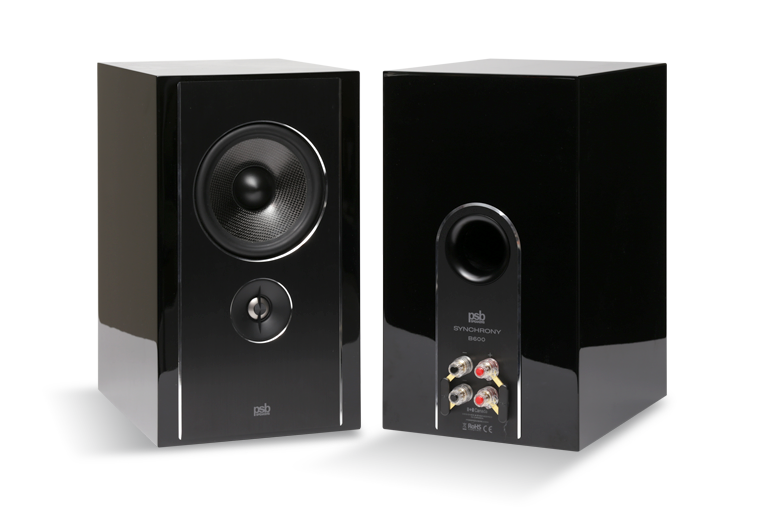
Description
PSB’s marketing literature for the B600 says: “Designed and engineered in Canada at the world-famous Acoustics Labs at Canada’s NRC by a team of highly regarded acoustic specialists guided by renowned PSB Founder and Chief Acoustic Designer, Paul Barton, this latest flagship bookshelf speaker builds on the advances introduced with previous generations of this venerated speaker line to deliver a truly immersive audio experience for movie and music lovers alike.” And if anyone doubts whether Barton is still intimately involved in the design of the company’s speakers, I can personally attest to having bumped into him fairly recently at the NRC lab while I was schlepping speakers in and out of the building to do the measurements that accompany our SoundStage! Network reviews. He was diligently measuring different driver configurations for what may have been a prototype of the speaker I now have in my room. And by the way, I found Barton to be an approachable, all-around nice guy—and one who has a wealth of knowledge about speaker design.
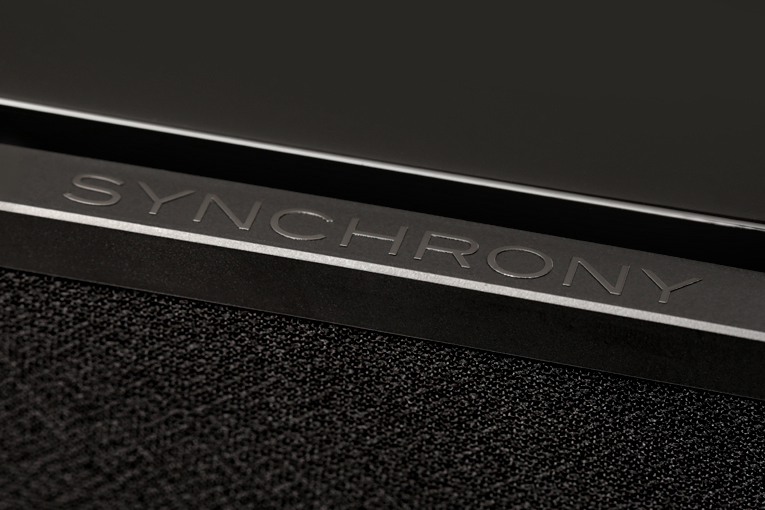
The B600 cabinet is a typical rectilinear box measuring 15.5″H × 9″W × 11.7″D. The speaker feels sturdy and weighs in at 23 pounds. The cabinet is built from heavily braced MDF, and the front baffle is clad with a sheet of black-anodized aluminum, which not only provides extra rigidity but scores extra points in the aesthetics category. The outer edges of the aluminum baffle and the cutouts for the drivers are mitered and finished to a shiny silver, which add a touch of flair, particularly with the reflective visual cues they give off. The edges and corners of the cabinet are slightly rounded; there are no visible joins, and the lacquered High Gloss Black finish of my review samples was immaculate. The B600 is also available in a Satin Walnut finish. Overall, the fit and finish of my review samples was first-rate, and I found the B600s attractive and stylish, but subdued enough to fit into any contemporary décor without calling undue attention to themselves.
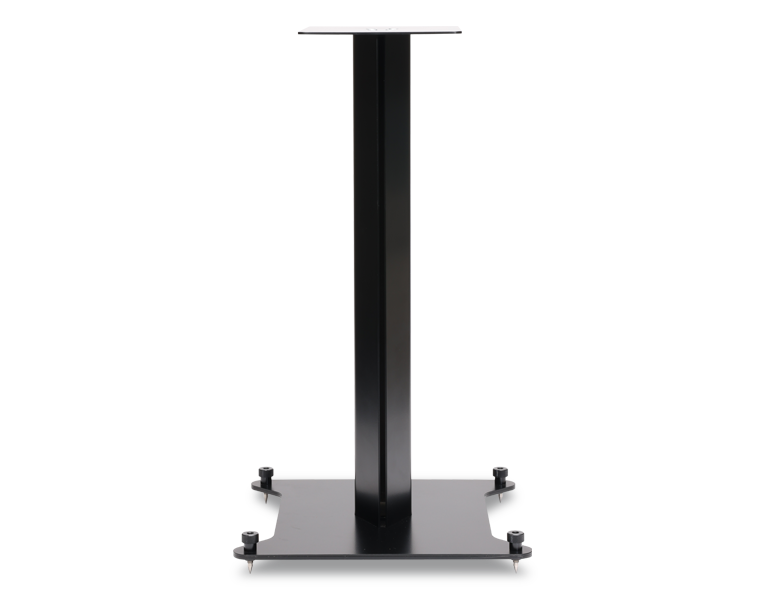
Integrated in the underside of the cabinet are four rubber isolators from IsoAcoustics, which, according to PSB, provide a high degree of isolation for the speaker by providing a secure, stable, and nonresonant connection to the supporting surface, such as a stand, shelf, or tabletop. Regarding supporting surfaces, PSB offers a matching 24″ stand for the B600 at $599 per pair. I was provided with a pair and thought they looked kinda plain—made entirely from matte-black painted steel, the stand is certainly not as pretty as the B600. While the appearance of the stand was a bit of a letdown, it does have a large top plate that accommodates the speaker’s IsoAcoustics footers, and four height-adjustable spikes that gave the speaker and stand a firm footing on the floor.
On the rear of the B600 are a bass-reflex port and two pairs of top-notch five-way binding posts, which, if you remove the supplied jumpers, accommodate biwiring. The posts and port are mounted on a small black-anodized aluminum plate that aesthetically matches the finish of the front baffle.
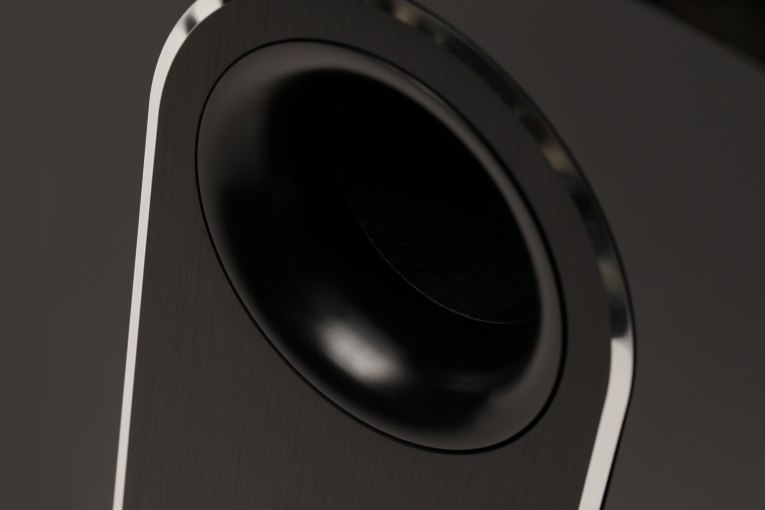
The B600’s single 6.5″ midrange-woofer sports a cast-aluminum basket, a woven carbon-fiber cone, and a rubber surround. Mounted below the midrange-woofer—an arrangement that’s a PSB hallmark—is a 1″ ferrofluid-cooled titanium-dome tweeter nestled in a small waveguide, which features a vertically extruded phase plug that covers the center of the tweeter dome. According to PSB: “The advanced driver assembly features four elements (Faraday ring, shorted turn, longer voice coil, symmetrical magnetic drive) that all work in harmony to reduce driver distortion.”
It’s worth pointing out something about the positioning of the tweeter below the midrange-woofer. When I first saw the configuration I thought that the B600s might sound dull on 24″ stands, because their tweeters would be a little low. But according to Paul Barton, the “acoustic center,” or “listening axis,” of the B600 is not at the tweeter height but 12″ up from the bottom edge of the cabinet, so a little bit above the midrange-woofer’s dust cap. This enables what he calls the ideal “summing behavior” of the two drivers. When the speaker is placed on a 24″ stand, the listening axis ends up about 36″ from the floor, which is a typical ear height for someone sitting in a listening chair.
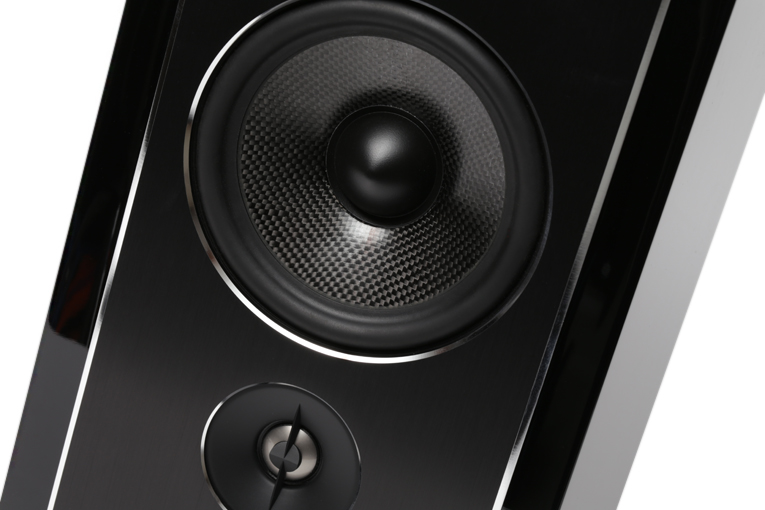
Setup
Each of my two review B600s came well packed in a large box that also contained an instruction manual and a magnetically attachable grille. I left the grilles off for my listening. I placed the B600s on the PSB-supplied stands and moved my reference Focal Sopra No1 speakers and stands out of the way, allowing me to put the PSBs in my usual speaker layout, where they form a 9′ equilateral triangle with my listening chair. I experimented with toe-in angle to see if my usual 15 degrees or so would be optimal—it was. With a little less toe-in, soundstage image sizes and specificity suffered. The rears of the speaker cabinets were about 22″ from the wall facing my listening chair.
My listening room is a relatively small (15′ × 12′) dedicated space, treated with broadband absorption at the first-reflection points and on the wall behind the speakers. I also have homemade bass traps in the front corners.
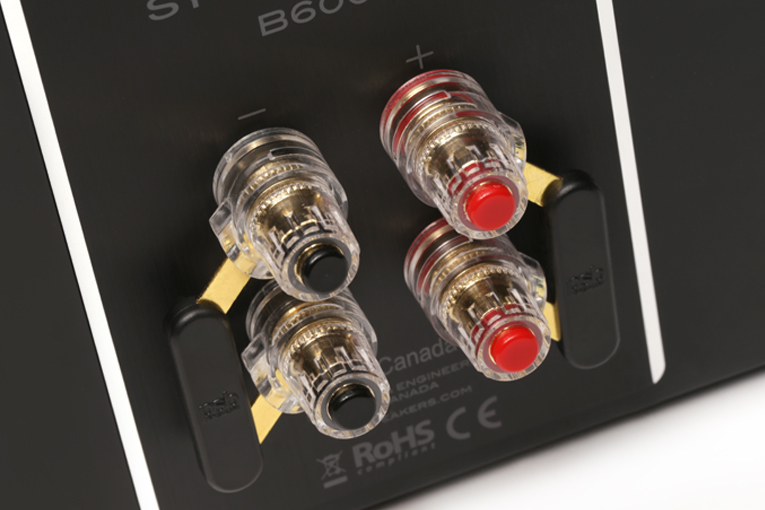
I connected the B600s to my McIntosh Laboratory MC302 amp using generic 12-gauge oxygen-free copper speaker wires terminated with locking banana plugs I soldered on myself. I used my Bluesound Node 2i as the source, which was connected to the S/PDIF coaxial input of my McIntosh Laboratory C47 preamplifier-DAC, which, in turn, fed my amp using balanced Monoprice interconnects. The Node 2i was a Roon endpoint for the Roon core application installed on a dedicated Windows 10 laptop connected via Ethernet to my home network, and controlled via the Roon remote app installed on my Microsoft Surface Pro 6. Qobuz and my ripped (to FLAC) CD library stored on a Synology NAS served as music sources.
Sound
After letting the B600s break in for about 24 hours, I sat down to listen critically. First up was Bonnie Raitt’s “I Can’t Make You Love Me,” from Luck of the Draw (16-bit/44.1kHz FLAC, Capitol Records). The opening brush of the cymbal, hard right, was reproduced with light, airy, shimmery goodness by the B600s, and at the right output level compared to the rest of the frequency range in the track. Raitt’s voice was locked at center stage, above and slightly behind the speaker plane, sounding smooth, effortless, and with attention-grabbing presence. The piano, spread across center stage behind Raitt, sounded real and authoritative with each key strike—those strikes floated freely between the speakers. Tonally, I thought, nothing seemed off with the B600s—they sounded like well-balanced, neutral speakers with little I could criticize.
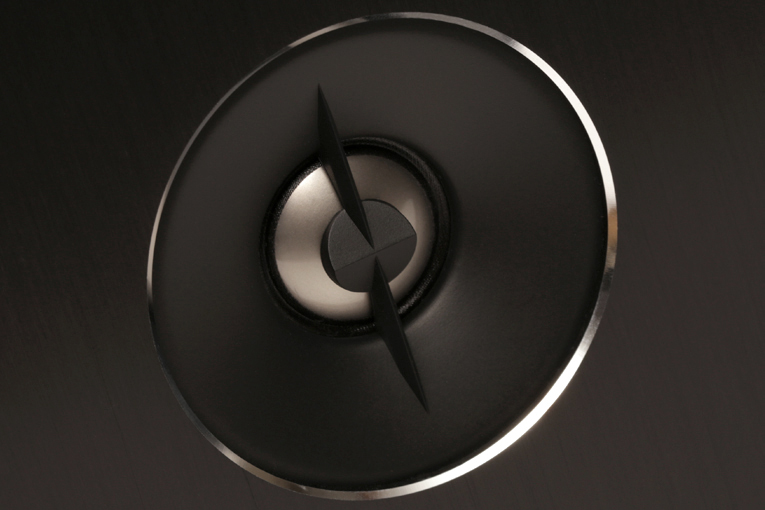
Imaging was first-rate on this track, exemplified by Ricky Fataar’s rhythmic cymbal strikes center-left, which occupied a well-defined volume in space. But it was the bass, of all things on such a soft, melodic track, that caused me to perk up in my chair when I turned up the volume. It was really deep and extended for standmounted speakers, and was very satisfying to listen to—and this compliment is coming from a guy who typically uses two big subwoofers in his reference system.
I had to try some hip-hop next, to see how deep and authoritative the bass really was out of these two-way boxes. The Weeknd’s “I Feel It Coming,” from Starboy (16/44.1 FLAC, Republic Records), like most modern hip-hop, has some deep bass. I turned the volume up slowly until I hit 95–100dB peaks (SPL, C-weighted)—and the PSBs didn’t break a sweat. The bass thumps underpinning the track were seriously punchy, to the point where I could feel them in my stomach. When bass notes would linger in the track, the PSBs kept pace with them and really surprised me, because I could “feel” the decays in the bass line viscerally. Impressed by this, I investigated with an in-room averaged frequency-response measurement using my calibrated miniDSP UMIK-1 microphone and the REW (Room EQ Wizard) software on my Surface Pro. I measured an astonishing -3dB point (relative to 2kHz) of 25Hz. As a matter of comparison, most two-way standmounted speakers based on a 6.5″ midrange-woofer that I’ve measured in the same positions in my room yield -3dB points around 32–35Hz. These measurements confirmed what I was hearing with the B600s—very deep bass for the speakers’ driver size and configuration. In fact, I’m pretty sure this is the most impressive bass extension I’ve ever measured—and heard—in my room from speakers of this type.
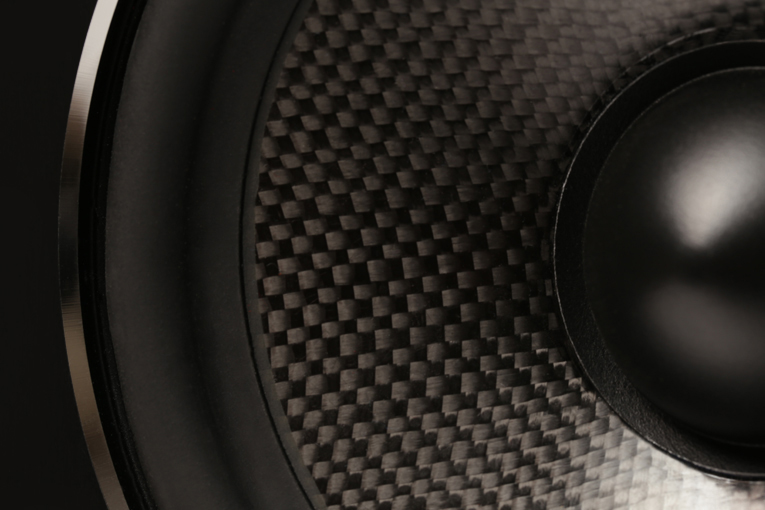
Next up, R.E.M.’s “Nightswimming,” from Automatic for the People (24/192 FLAC, Craft Recordings/Qobuz). The opening bars played on piano, positioned center-right, had weight, authority, and definition. The leading edges of the notes sounded neither ringy and strident, nor soft and ill-defined. When singer Michael Stipe’s voice enters, flying high above the speaker plane, taking center stage above and to the left of the piano, the PSBs revealed every nuanced intonation captured in the recording and positioned the sonic image perfectly within the soundstage.
“Nightswimming” is a well recorded, multilayered, multidimensional track, which features a string section arrayed center-left and behind Stipe, as well as hard right. These recorded sounds were also beautifully reproduced by the B600s, with convincing bite, but without ever sounding hard. The piano, played solo at the beginning, was always easy to track through the PSBs, even when the song became instrumentally dense. The B600s, though relatively small in stature, threw a very wide and tall soundstage, with laser-like delineation between all of the song’s complex musical elements.

I followed up that song with Michael Bublé’s “Help Me Make It Through the Night,” from his album Love (24/96 FLAC, Reprise Records/Qobuz). The opening acoustic guitar, played by Graham Dechter, had attention-grabbing sparkle, cleanly occupying its own space center-right. Bublé’s voice, floating a clear two feet above the plane defined by the tops of the speakers, sounded rich and smooth, with oodles of body. If I had to nitpick here, I’d argue perhaps a tad too much body, leaning toward chesty—but that would be a minor quibble. Loren Allred’s vocal, higher in pitch, certainly did not sound chesty; rather, it had a glowing, effortless quality, seemingly floating on a cloud. I could hear the subtle drumming, positioned center-left and several feet behind the vocalists, being delivered with nimble speed.
During the chorus, when Bublé and Allred are singing together, centered on the stage, the B600s showed me that Bublé is taller than Allred—at least in the way the track was recorded—with his voice imaging slightly above hers. Chris Walden’s strings, mixed center-left and center-right, and Kye Palmer’s trumpet, positioned center stage, sounded perfectly delineated from each other and the other sounds in the track, each occupying its own sonic space within the soundstage. Strong, deep, quick, and punchy bass underpins this track, and the B600s faithfully reproduced all these elements of the lower frequencies. I was amazed to hear such a performance from a two-way standmount design. The B600s definitely sounded like much bigger speakers than they are.
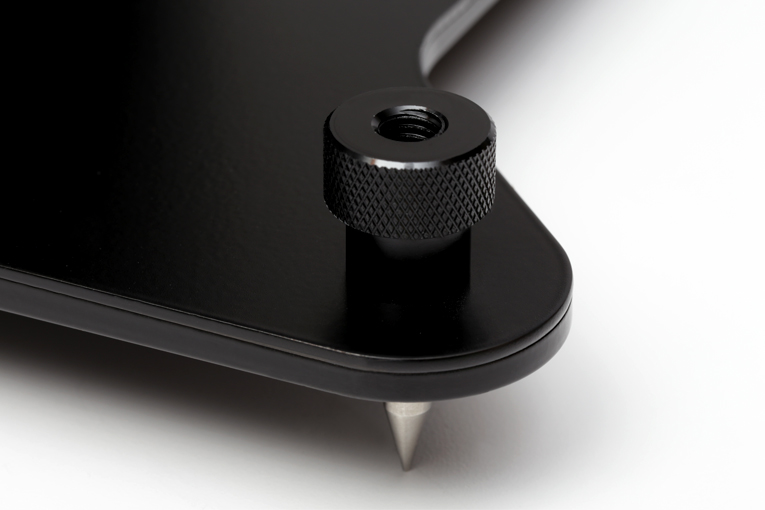
Comparisons
I made level-matched comparisons between the PSB B600s and a pair of Revel M126Be standmounts, which, at $4400 for the pair, are priced about 75% higher. The M126Be has a similar driver complement—a 6.5″ midrange-woofer and a 1″ tweeter, though the tweeter has a beryllium dome rather than the B600’s titanium dome. I used pink noise and an SPL meter and found the PSBs to have the same sensitivity as the Revels in my room, which was convenient—I didn’t have to alter my preamp’s output volume when comparing the speakers.
Ideally, I wouldn’t have any preconceived notions about the outcome of these direct comparisons, but I can’t help it, I’m human. In this case, I knew going in that both of these competently designed speakers are engineered to sound neutral, following each company’s evolution of the NRC-derived frequency-response curve for in-room performance. So, did I hear similar tonality from top to bottom from both speakers? Yes, absolutely, with one key difference at the lowest reaches of the frequency spectrum—the PSBs easily outclassed the Revels in terms of bass extension, and also had slightly more impact and punch in the midbass region.
For example, when listening to Raitt’s “I Can’t Make You Love Me” through the PSBs, the first thing I noticed was the extra fullness in the bass, which gave more “feel” in the seat of my chair. Overall, the PSBs delivered a more satisfying listening experience. Please note that I consider the Revels to have good, solid bass for average-sized standmounted speakers—it’s just that the B600s are not simply good, but great in this regard. However, the rest of the frequency range was close to identical for both pairs of speakers, at least to my ears. The Revels might’ve exhibited a hair more sibilance than the PSBs on Raitt’s S sounds on the track, with the PSBs delivering a more relaxed sound, but it was close. Conversely, I think I heard more nuanced microdetail, or shimmer, as I like to call it, in the cymbal crashes through the Revels. But, honestly, I was splitting hairs—outside of the bass region, the two sets of speakers sounded very similar.
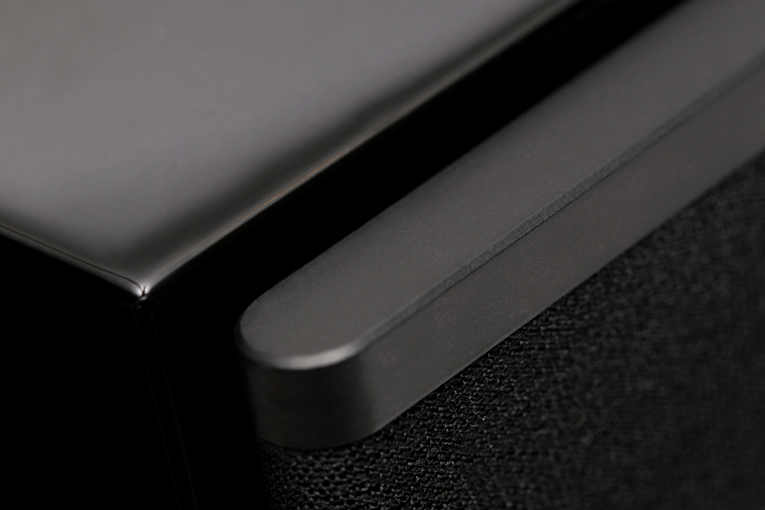
In terms of imaging precision, I’d call it a draw, with both speakers chiseling out very specific aural images in and around the soundstage. Where the Revels did pull away slightly from the PSBs, and earned their bump in asking price, was in that difficult-to-describe quality that I call sonic transparency. To me, a high degree of transparency is that feeling that individual sounds produced by the speakers don’t sound like they are coming from an electromechanical device in a box, but rather as if they’re floating freely in the air, without any cabinet sounds (i.e., resonances, vibrations, etc.), no matter how subtle, to blur or detract from the listening experience. In other words, it’s how well the speakers disappear into the soundstage. Bottom line: both the PSBs and the Revels sounded very transparent, but the Revels were ever so slightly more so. For instance, when I focused on both the piano notes and Raitt’s voice in “I Can’t Make You Love Me,” the three-dimensional sonic “bubbles” containing each soundstage image floated with a little more freedom, and with a greater sense of delineation and solidity, when played back through the Revels.
I heard more of the same from the other tracks. With “Nightswimming,” the PSBs had more weight in the lower-register piano notes, as well as more body and smoothness in Michael Stipe’s voice. These sounds were rendered with a little more transparency through the Revels, but on this track, with its multiple layers of instruments strewn across the soundstage, I found the PSBs threw a taller and wider stage, giving a larger, grander sense of scale. On Michael Bublé’s “Help Me Make It Through the Night,” I heard the same small gap in transparency in favor of the Revels with the opening guitar plucks, as well as with Bublé’s and Allred’s vocals. But this track has strong and impactful bass, which is where the PSBs had a definite advantage over the Revels, so I picked the PSBs as the winners without hesitation.
Lastly, I used Audioslave’s “Like a Stone,” from Audioslave (16/44.1 FLAC, Epic Records/Interscope Records/Qobuz), as a means of comparing both speakers with some harder-hitting music. It was no contest! The PSBs could rock out better than the Revels, thanks to bass extension I could feel in my legs and kick-drum punch I could feel in my gut. The PSBs delivered a bigger sound overall, especially in the chorus with the multiple layers of guitars and Chris Cornell’s howling vocals. Both speakers sounded very clean even at loud volumes, mind you, but the PSBs sounded bigger and bolder.
When I wrapped up this two-way speaker showdown, and had scribbled plenty of listening notes, I decided to look at the averaged in-room frequency plots for both pairs of speakers on the same graph in REW to see if the Revels and PSBs did in fact measure as close as they sounded. They did. Aside from the obvious extra bass extension on the PSBs, and a 1dB rise at 6kHz for the Revels versus a 1dB dip for the PSBs around the same frequency, the two frequency-response plots followed one another almost perfectly to just beyond 10kHz. If I was made to choose between these two fine, tonally accurate speakers, my answer would depend on the circumstances, but what follows is how I’d sum it up. Without a subwoofer, I’d choose the PSBs, hands down. With a subwoofer, I’d choose the Revels by a hair if I didn’t care about money—remember, they cost about 75% more. But if I was on a budget I’d still go with the PSBs, even if I already had a sub.
Conclusion
What’s not to like about the PSB Synchrony B600? After spending a few weeks with the review pair, in a word, my answer is nothing. The B600 is one of the most complete-sounding small speakers I’ve ever heard. In my relatively small room, the B600s offered exceptional bass extension down to 25Hz (-3dB, relative to 2kHz), and they showcased mid- and upper-bass output that was quick, articulate, and punchy. The midrange was detailed and layered, and the top end airy and delicate. Most importantly, the entire frequency spectrum sounded perfectly balanced from the B600s in my room. To paraphrase a famous children’s fairytale: they were not too hot, not too cold, but just right! Or, in audiophile terms, the B600s were not too bright or forward, not too dull or laid-back, but neutral, honest, and pleasing. These listening impressions were plainly corroborated by my in-room measurements.
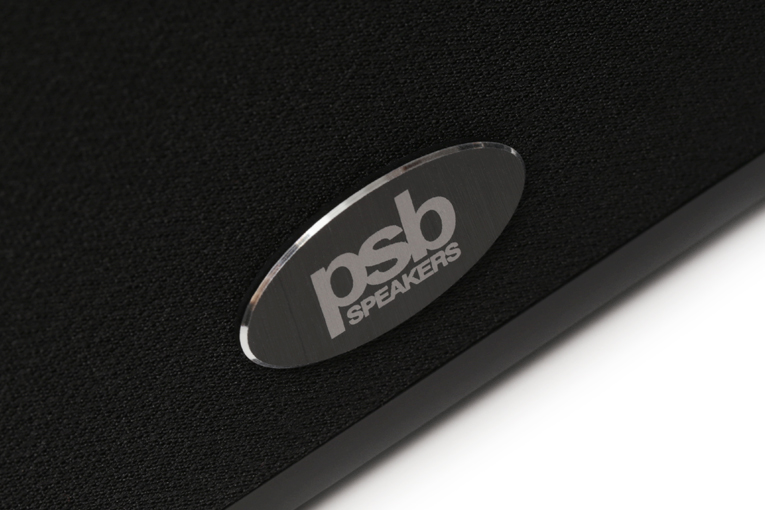
In terms of more intangible qualities that are difficult to correlate to objective measurements but are easy to hear, such as imaging precision, soundstage dimensions, and transparency, again, the PSB B600s did not disappoint. When directly compared with a pair of Revel M126Be loudspeakers—which cost about 75% more and are considered by many to be a neutral and exemplary reference insofar as standmounted speakers go—the B600s gave up a sliver of transparency, but equaled their imaging precision, threw a larger soundstage, and generated deeper and more detailed bass. So if you’re looking for extreme high quality in a standmount speaker at any price, especially if you won’t or can’t incorporate a subwoofer in your room, you absolutely must audition a pair of PSB Synchrony B600s. Once you do, my bet is you’ll see no reason to keep searching. Even after 49 years of designing speakers, Paul Barton can still impress—his new PSB Synchrony B600 is proof of that.
. . . Diego Estan
diego@soundstage.com
Associated Equipment
- Speakers: Revel M126Be, Focal Sopra No1.
- Subwoofer: SVS SB-4000 (2).
- Power amplifier: McIntosh Laboratory MC302.
- Crossover: Marchand Electronics XM446XLR-A.
- Preamplifier-DAC: McIntosh Laboratory C47.
- Room correction EQ: MiniDSP DDRC-22D with Dirac Live 3.0 (between digital sources and DAC).
- Digital sources: Bluesound Node 2i streamer, Windows 10 laptop running Roon.
- Speaker cables: 12AWG oxygen-free copper terminated with locking banana plugs.
- Analog interconnects: AmazonBasics RCA, Monoprice Premier Series XLR.
- Digital interconnect: AmazonBasics optical digital audio TosLink.
PSB Synchrony B600 Loudspeakers
Price: $2499 per pair.
Warranty: Five years, parts and labor.
PSB Speakers
633 Granite Court
Pickering, Ontario L1W 3K1
Canada
Phone: (905) 831-6555
Fax: (905) 831-6936
Website: www.psbspeakers.com






















